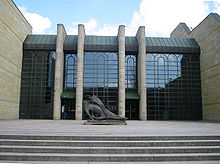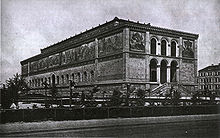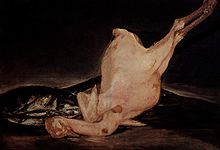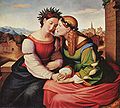- Neue Pinakothek
-
The Neue Pinakothek (New Pinakothek) is an art museum in Munich, Germany. Its focus is European Art of the 18th and 19th century and is one of the most important museums of art of the nineteenth century in the world. Together with the Alte Pinakothek and the Pinakothek der Moderne it is part of Munich's "Kunstareal" (the "art area").
Contents
The building
The museum was founded by the former King Ludwig I of Bavaria in 1853. The original building constructed by Friedrich von Gärtner and August von Voit was destroyed during World War II. The ruin of the Neue Pinakothek was demolished in 1949. Designed by architect Alexander Freiherr von Branca the new postmodern building opened in 1981.
History
Ludwig began to collect contemporary art already as crown prince in 1809 and his collection has been steadily enlarged. When the museum was founded the separtation to the old masters in the Alte Pinakothek was fixed with the period shortly before the turn of the 19th century, which has become a prototype for many galleries.
The delimitation to the modern painters displayed in the Pinakothek der Moderne was later fixed by taking the restart of Henri Matisse and the Expressionists into account (ca. 1900). Consequentially a painting of Matisse acquired by the "Tschudi Contribution" is displayed in the Pinakothek der Moderne. The so-called Tschudi Contribution in 1905/1914 led to an extraordinary collection of masterpieces of Impressionism and Post-Impressionism. Hugo von Tschudi, general director of the State Collections acquired 44 paintings, nine sculptures and 22 drawings, mostly from new French artists. But since public funds could not be used to purchase these works, Tschudi’s associates came up with the money from private contributions after his death in 1911.
In 1915 the Neue Pinakothek became the property of the Bavarian state. A self-portrait of Vincent van Gogh was confiscated in 1938 by the Nazi regime as degenerate art and sold one year later.
Collection
The museum is under supervision of the Bavarian State Painting Collections which houses an expanded collection of more than 3.000 European paintings from classicism to art nouveau. About 400 paintings and 50 sculptures of these are exhibited in the New Pinakothek.
- International paintings of the second half of 18th century:
- Among others the gallery exhibits works of Francisco de Goya (Plucked Turkey) (Don José Queraltó as a Spanish Army doctor), Jacques-Louis David (Anne-Marie-Louise Thélusson, Comtesse de Sorcy), Johann Friedrich August Tischbein (Nicolas Châtelain in the garden) and Anton Graff (Heinrich XIII, Graf Reuß).
- English paintings of 18th and early 19th century:
- It's one of the largest collections outside the United Kingdom with masterpieces of Thomas Gainsborough (Mrs. Thomas Hibbert) (Landscape with Shepherd and Flock), William Hogarth (Richard Mounteney), John Constable (View of Dedham Vale from East Bergholt), Joshua Reynolds (Captain Philemon Pownall), David Wilkie (Reading the Will), Thomas Lawrence (The Two Sons of the 1st Earl of Talbot), George Romney (Catherine Clements), Richard Wilson (View of Syon House Across the Thames near Richmond Gardens), Henry Raeburn (Mrs. J. Campbell of Kilberry), George Stubbs (The pointer) and J. M. W. Turner (Ostende).
- German artists of Classicism in Rome
- like Friedrich Overbeck (Italia and Germania), Friedrich Wilhelm von Schadow (The Holy Family beneath the Portico), Heinrich Maria von Hess (Marchesa Marianna Florenzi), Peter von Hess (The Entry of King Othon of Greece into Nauplia) and Peter von Cornelius (The three Marys at the Tomb).
- with paintings of Caspar David Friedrich (Garden Bower), Karl Friedrich Schinkel (Cathedral Towering over a Town) und Carl Blechen (Building of the Devil's Bridge) and others.
 Carl Spitzweg The Poor Poet 1839
Carl Spitzweg The Poor Poet 1839
- represented by Franz Xaver Winterhalter (Graf Jenison-Walworth), Carl Spitzweg (The Poor Poet) , Moritz von Schwind (A Symphony) and Ferdinand Georg Waldmüller (Young Peasant Woman with Three Children at the Window).
- French Realism and French Romanticism
- with Eugène Delacroix (Clorinda Rescues Olindo and Sophronia), Théodore Géricault (Artillery Train Passing a Ravine), Gustave Courbet (Landscape near Maizières), Jean-François Millet (Farmer Inserting a Graft on a Tree), Honoré Daumier (The Drama) and others.
- Deutschrömer (or German-Romans)
- such as Hans von Marées (Self-Portrait), Arnold Böcklin (Pan in the Reeds), Anselm Feuerbach (Medea) and Hans Thoma (Landscape in the Taunus).
- History paintings
- with Wilhelm von Kaulbach ( King Ludwig I sourronded by artists), Karl Theodor von Piloty (Seni and Wallenstein), Franz von Defregger (Das letzte Aufgebot) and Hans Markart (Die Falknerin).
- German Realism
- like Wilhelm Leibl (Portrait of Frau Gedon), Franz von Lenbach (Aresing Village Street) and Adolph Menzel (Living-Room with the Artist's Sister).
- German Impressionists
- especially Max Liebermann (Boys Bathing), Lovis Corinth (Eduard, Count von Keyserling) und Max Slevogt (The Day's Work Done).
 Edouard Manet Luncheon in the Studio 1868.
Edouard Manet Luncheon in the Studio 1868.
- French Impressionists
- One of the world's leading collections with masterpieces of Pierre-Auguste Renoir (Portrait of a Young Woman), Edouard Manet (Lucheon in the Studio) (Monet Painting on His Studio Boat), Claude Monet (The Bridge at Argenteuil), Paul Cézanne (The Railway Cutting), Paul Gauguin (The Birth - Te tamari no atua), Edgar Degas (Woman Ironing), Camille Pissarro (Street in Upper Norwood), Alfred Sisley (The Road to Hampton Court), Georges-Pierre Seurat and Vincent van Gogh (Sunflowers) (The Weaver).
- Symbolism and Art Nouveau and early 20th century
- represented among others by Giovanni Segantini (L'aratura), Gustav Klimt (Margaret Stonborough-Wittgenstein), Paul Signac (S.Maria della Salute), Maurice Denis (Gaulish Goddess of Herds and Flocks), Henri de Toulouse-Lautrec (Le jeune Routy à Céleyran), James Ensor (Still Life in the Studio), Edouard Vuillard (Café Scene), Ferdinand Hodler (Tired of Life), Franz von Stuck (The Sin), Edvard Munch (Woman in Red Dress (Street in Aasgaardstrand)), Walter Crane (Neptun's horses), Thomas Austen Brown (Mademoiselle Plume rouge), Pierre Bonnard (Lady at the Mirror) and Egon Schiele (Agony).
- Sculptures
- Also sculptures of the 19th century are exhibited, for example works of Bertel Thorvaldsen (Adonis), Antonio Canova (Paris), Rudolph Schadow (Woman Tying Her Sandal), Auguste Rodin (Crouching Woman (La femme accroupie)), Max Klinger (Elsa Asenijeff), Aristide Maillol (La Flore), Pablo Picasso (Le Fou) and others.
Gallery
- Other works in the collection of the Neue Pinakothek
-
Jacques-Louis David —
Anne-Marie-Louise Thélusson, Comtesse de Sorcy -
Thomas Gainsborough —
Mrs. Thomas Hibbert -
Eugène Delacroix —
Clorinda Rescues Olindo und Sophronia -
Max Liebermann —
Boys Bathing -
Claude Monet —
The Bridge at Argenteuil -
Paul Gauguin —
Te tamari no atua -
Paul Cézanne —
The railway cutting -
Vincent van Gogh —
Sunflowers -
Toulouse-Lautrec —
Le jeune Routy à Céleyran -
Edvard Munch —
Woman in Red Dress (Street in Åsgårdstrand) -
Honoré Daumier —
Don Quichotte and Sancho Pansa c. 1868 -
Bertel Thorvaldsen—
Head of a warrior c. 1812 -
Auguste Rodin—
Man with broken nose c. 1863
External links
- Official website (in English)
- website (in German)
- Article about the Neue Pinakothek
- Lionel Gossman. “Making of a Romantic Icon: The Religious Context of Friedrich Overbeck’s ‘Italia und Germania.’” American Philosophical Society, 2007. ISBN 0871699753. [1]
 Königsplatz · Glyptothek · Staatliche Antikensammlung · Lenbachhaus · Alte Pinakothek · Neue Pinakothek · Pinakothek der Moderne · Museum Brandhorst · Staatliche Graphische Sammlung München · Staatliche Sammlung für Ägyptische Kunst
Königsplatz · Glyptothek · Staatliche Antikensammlung · Lenbachhaus · Alte Pinakothek · Neue Pinakothek · Pinakothek der Moderne · Museum Brandhorst · Staatliche Graphische Sammlung München · Staatliche Sammlung für Ägyptische Kunst Categories:
Categories:- Art museums and galleries in Germany
- Museums in Munich
- National museums of Germany
Wikimedia Foundation. 2010.


















